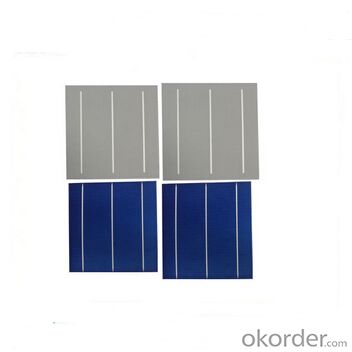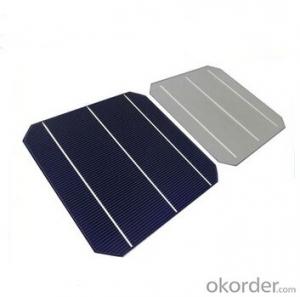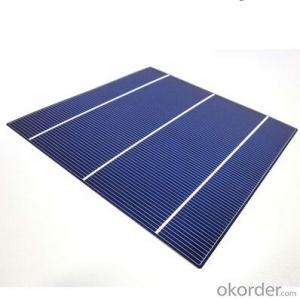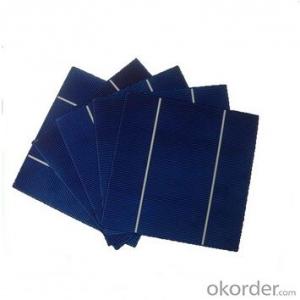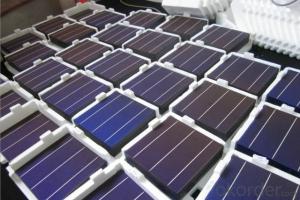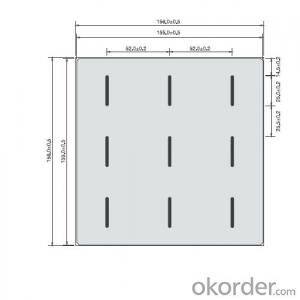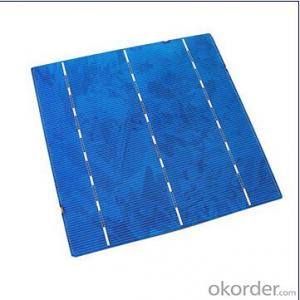High Quality Polycrystalline Solar Cell 190um ± 20um - Cost of Silicon Solar Cells
- Loading Port:
- Shanghai
- Payment Terms:
- TT OR LC
- Min Order Qty:
- 1000 pc
- Supply Capability:
- 1000000 pc/month
OKorder Service Pledge
OKorder Financial Service
You Might Also Like
Solar Cells:
solar cells, when struck by photons of light from the sun, generates an electrical current which can then be used to power DC or AC electrical loads.
A solar cell is made of silicon. Computer chips are made of this same material. Basically, when light strikes the surface of a solar cell some of it is absorbed into the silicon. This light energy bumps the electrons loose and causes energy to flow
Solar cells is made by solar wafer, it has three categories of solar cell right now, monocrystalline polycrystalline and thin film,These cells are entirely based around the concept of PN junction, which is the critical part of solar module, it is the part that can convert the light energy into electricity, the thickness is from 180um to 200um, with even busbars to conduct electricity, textured cell can decrease diffuse reflection; they are often electrically connected and encapsulated as a module. Photovoltaic modules often have a sheet of glass on the front (sun up) side, allowing light to pass while protecting semiconductor wafers from abrasion and impact due to wind-driven debris, rain, hail, etc. Solar cells are also usually connected in series in modules, creating an additive voltage. Connecting cells in parallel will yield a higher current;With high quality and stable quality. Our Cells can greatly improve the performance of Solar Modules.
Specifications
Efficiency (%) | Pmpp (W) | Voc (V) | Isc (A) | Imin (A) |
18.6 | 4.53 | 0.637 | 8.84 | 8.53 |
18.4 | 4.48 | 0.635 | 8.81 | 8.48 |
18.2 | 4.43 | 0.633 | 8.77 | 8.43 |
18 | 4.38 | 0.631 | 8.73 | 8.38 |
17.8 | 4.33 | 0.629 | 8.69 | 8.33 |
17.6 | 4.28 | 0.627 | 8.65 | 8.27 |
17.4 | 4.23 | 0.624 | 8.61 | 8.22 |
17.2 | 4.19 | 0.621 | 8.56 | 8.16 |
Features:
High efficiencies up to 16.4%
Proven long term mechanical stability of silicone
Make of highly purified poly silicone
Three bus bars for reduced series resistance and improved module and cell efficiency
Blue anti-reflecting coating ensures improved light absorption and increased efficiency
Acid texturization offers a uniform appearance and virtually invisible crystal structure
Excellent low light behavior for improved energy yield
Solar Cells Advantage:
• High efficiency and stable performance in photovoltaic conversion.
• Advanced diffusion technique ensuring the homogeneity of energy conversion efficiency of the cell.
• Advanced PECVD film forming, providing a dark blue silicon nitride anti-reflection film of homogenous color and attractive appearance.
• High quality metal paste for back surface and electrode, ensuring good conductivity, high pulling strength and ease of soldering.
• High precision patterning using screen printing, ensuring accurate busbar location for ease with automatic soldering a laser cutting.
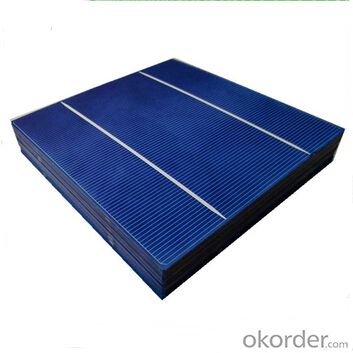
FAQ
We have organized several common questions for our clients,may help you sincerely:
①What price for each watt?
It depends on the efficiency of the solar cell, quantity, delivery date and payment terms.
②How long can we receive the product after purchase?
In the purchase of product within three working days, We will arrange the factory delivery as soon as possible. The pecific time of receiving is related to the state and position of customers.Commonly 7 to 10 working days can be served.
③Can you provide the peripheral products of the solar panels, such as the battery, controller, and inverter? If so, can you tell me how do they match each other?
Yes, we can, we have two companies for solar region, one is CNBM International, the other is CNBM engineering Co.
We can provide you not only the solar module but also the off grid solar system, we can also provide you service with on grid plant.
④What is your warranty of solar cell?
Our product can promise lower than 0.3% open box crack, we support claim after opening the box if it has crackm color difference or sth, the buyer should give pictures immediately, we can not accept the claim after the solar cell has assembled to solar panel.
• Timeliness of delivery
• ⑤How do you pack your products?
We have rich experience on how to pack the solar cell to make sure the safety on shipment, we could use wooden box or pallet as buyer's preference.
- Q: Can solar cells be used for off-grid power supply?
- Yes, solar cells can be used for off-grid power supply. Solar cells, also known as photovoltaic cells, convert sunlight into electricity. These cells can be used to generate electricity in remote areas or locations where the traditional power grid is unavailable or unreliable. Solar panels can be installed on rooftops or in open spaces to capture sunlight and produce electricity, which can then be stored in batteries for use during non-sunlight hours or when needed. This makes solar cells an efficient and sustainable solution for off-grid power supply.
- Q: How do solar cells perform in areas with frequent tornadoes?
- Solar cells can still perform efficiently in areas with frequent tornadoes as they are designed to withstand extreme weather conditions. However, the installation and mounting of solar panels in tornado-prone regions should be done with utmost care and consideration of local building codes to ensure their resilience against high winds. Additionally, regular maintenance and inspection of the solar panels may be required to address any potential damage caused by tornadoes.
- Q: How do solar cells handle high winds or hurricanes?
- Solar cells are designed to be resilient and can withstand high winds and hurricanes. They are typically installed securely and firmly on rooftops or in ground-mounted systems. Additionally, solar panels are built with durable materials and undergo rigorous testing to ensure they can withstand extreme weather conditions. In regions prone to hurricanes, solar installations are often engineered to meet specific wind load requirements to ensure their stability.
- Q: How do solar cells perform in tropical climates?
- Solar cells perform well in tropical climates due to the abundance of sunlight and high temperatures found in these regions. The intense sunlight allows solar cells to generate a higher amount of electricity, while the warmer temperatures can actually increase the efficiency of the cells. Additionally, solar panels are designed to withstand harsh weather conditions, including high humidity and heavy rain, commonly found in tropical climates.
- Q: Can solar cells be used to power outdoor lighting systems?
- Yes, solar cells can be used to power outdoor lighting systems. Solar cells, also known as photovoltaic cells, convert sunlight into electricity. This electricity can be stored in batteries or used directly to power outdoor lighting systems, eliminating the need for traditional electrical wiring or reliance on grid electricity. Solar-powered outdoor lighting systems are efficient, cost-effective, and environmentally friendly solutions for illuminating outdoor spaces.
- Q: Can solar cells be installed on any type of roof?
- Yes, solar cells can be installed on any type of roof, including flat, sloped, metal, tile, and asphalt roofs. However, the suitability and feasibility of installation may vary depending on factors such as roof orientation, shading, structural integrity, and local regulations. It is recommended to consult with a professional solar installer to determine the best options for your specific roof type.
- Q: Can solar cells be used to power remote locations?
- Yes, solar cells can be used to power remote locations. Solar cells convert sunlight into electricity, making them an ideal renewable energy source for areas that are not connected to the traditional power grid. They can be installed in remote locations to generate electricity and provide a reliable power supply. Additionally, solar cells are low-maintenance and have a long lifespan, making them a cost-effective solution for powering remote areas.
- Q: Can solar cells be used in smart home automation systems?
- Yes, solar cells can be used in smart home automation systems. Solar cells can provide renewable and clean energy to power various devices and systems in a smart home, including lighting, heating, cooling, and even smart appliances. By integrating solar cells into the automation system, homeowners can reduce their reliance on traditional energy sources, lower their electricity bills, and contribute to a more sustainable and environmentally friendly home.
- Q: Can solar cells be used to power electric gates?
- Yes, solar cells can be used to power electric gates. Solar panels can capture sunlight and convert it into electricity, which can then be used to power various devices, including electric gates. This renewable energy source provides a sustainable and cost-effective solution for powering electric gates in areas where electricity supply is limited or unavailable.
- Q: Can solar cells be used for powering drones?
- Yes, solar cells can be used for powering drones. By converting sunlight into electricity, solar cells can provide a renewable source of power to drones, reducing the need for traditional batteries and increasing flight duration. Additionally, solar-powered drones have the potential to operate for extended periods without the need for frequent recharging, making them more sustainable and cost-effective in various applications.
Send your message to us
High Quality Polycrystalline Solar Cell 190um ± 20um - Cost of Silicon Solar Cells
- Loading Port:
- Shanghai
- Payment Terms:
- TT OR LC
- Min Order Qty:
- 1000 pc
- Supply Capability:
- 1000000 pc/month
OKorder Service Pledge
OKorder Financial Service
Similar products
Hot products
Hot Searches
Related keywords


